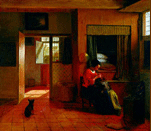










14.
Constructing the Female Body:
Debased, Mutilated, and Dead Bodies in Religious Images
Organizers:
This workshop will be concerned with this artistic treatment of the female religious figure as it relates to social conceptions of women, the contemporaneous interest in anatomy, and the role of the degenerate female body in Christian thought and practice. In a ten-minute introductory period, we will survey the individual interests of the participants, allowing us to tailor the discussion and tap into the expertise of those in the room. We will also run through the visual material on hand so that participants know what is available to refer to during the discussion.
In the first half-hour, we will focus the discussion on artworks originating in Northern Europe before the Reformation. The female body appears repeatedly in the figures of Eve, the virgin martyrs, and women in Last Judgment scenes, where the physicality of the female body restructures the narrative and meaning of religious images in order to instruct and inspire the viewer. How does the mode of representation reinforce the popular understanding and the sacred perception of the female body? How does the image function within the context of the Pre-Reformation period? What do the artworks teach about the theological status of women in the North?
The second part of our discussion will concentrate on Southern
Europe. The female body, particularly epitomized by the figure of the Virgin
Mary, followed very specific canons of representation following the edicts
of the last Council of Trent. However, exceptions, such as Caravaggio’s
1605 Death of the Virgin, reevaluated the theological qualities assigned to
female bodies in Post-Tridentine images and instead emphasized the corporeality
of the female body. We would like to raise questions pertaining to the shift
that occurred when the actual physicality of the Mother of Christ, or of a
female saint, was highlighted: did such an emphasis effectively generate responses
such as religious emotions in the viewer? How would an artist have treated
a male body differently in a Post-Tridentine religious image? How did the
theological and anatomical environments influence depictions of the female
body in sacred images?
The final segment of our discussion will be reserved for a comparative analysis
of the inflected representation of women in Europe. By addressing the degree
to which the treatment of women bodies redirected the focus of religious imagery,
this workshop wishes to raise new questions in the fields of art history,
history of medicine, and religious studies. By considering the primacy of
the sacred female figure as a physical body, we hope to explore the priority
of the gendered body as a rhetorical device within a religious image. Therefore,
the second plenary, Degree, Priority and Place would be the best platform
for the expansion of this particular workshop. We encourage participants to
bring their own questions and images which may further the discussion.
List of Readings:
|
|
|
||||||
|
|
 |
 |
|
||||
 |
|
 |
|
||||
|
|
|
||||||
|
|
|
||||||
 |
|
||||||
|
|
|
||||||
| |
|
||||||
 |
|
||||||
 |
|
||||||
 |
|
||||||
 |
|
||||||
|
|
|
||||||
|
|
 |
|
|
||||
 |
|
||||||
|
|
|
|
|
|
|
|
|